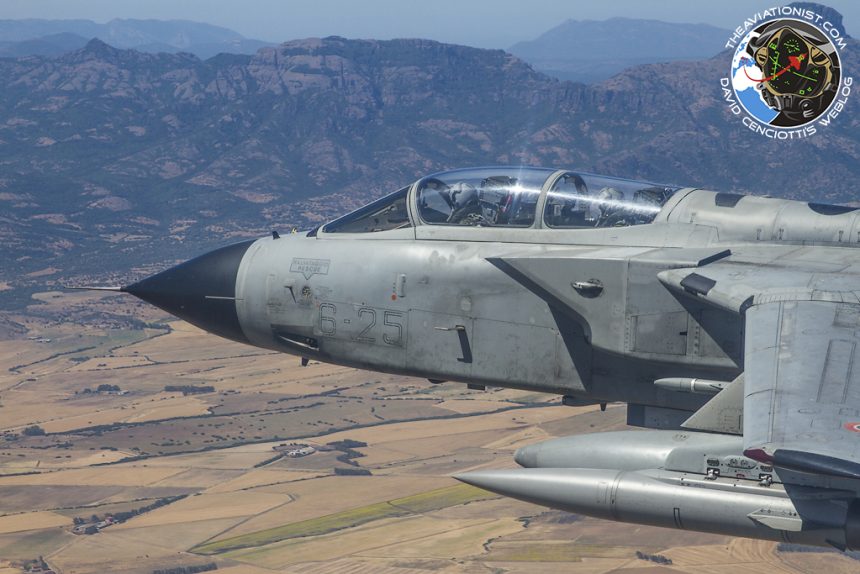As the Tornado completes its final days of service with the Royal Air Force, which is about to become the first operator to retire the type, we have looked at the how the Italian Air Force Tornado IDS and ECR training in the air-to-ground role.
“We usually deploy to Decimomannu three times a year, for firing campaigns lasting two weeks. During such deployments, we are also able to rotate the aircrews and, if necessary, the aircraft. In particular, the activity at the range is required to achieve the CR (Combat Ready) qualification. Moreover, during this campaign we plan to undertake some air-to-air activity too, focusing on the employment of the IR-guided missile and gun, even though we would use these armaments for self-defence purposes only.”
These are the words used by Lt. Col. Fabio S. (full name is withheld for security reasons), Commander of the 154° Gruppo (Squadron) belonging to the 6° Stormo (Wing) from Ghedi, interviewed in one of the briefing rooms made available here in “Deci” (as the airbase is dubbed in the pilot community) by the local-based RSSTA (Reparto Sperimentale e di Standardizzazione Tiro Aereo – the Air Gunnery Standardization and Experimentation Unit).
The missions flown by the IDS and ECR fleets (respectively A-200C and EA-200B in accordance with the Italian MoD Mission Design Series) in Sardinia complement the activities carried out during the rest of the year from the 6° Stormo’s homebase, at Ghedi airbase, in northern Italy that consist of medium and low level training sorties,“recce” missions, aerial support to the Esercito Italiano (Italian Army) or Marina Militare (Italian Navy) units, as well as a couple of monthly COMAOs (Combined Air Operations).
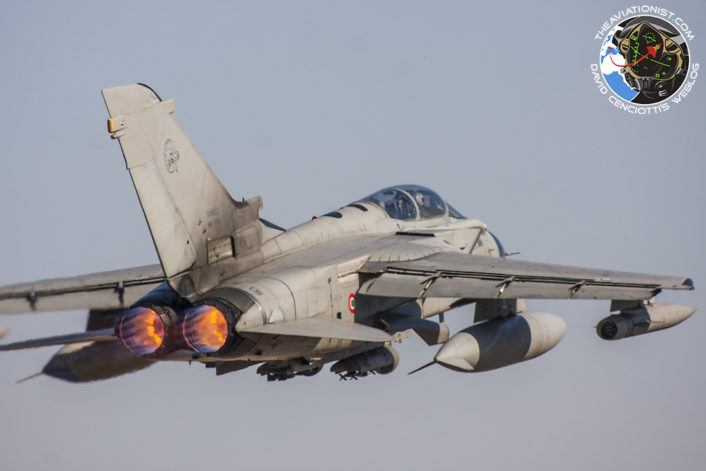
Among the “non-standard” activities carried out at home there is also the participation to national and multinational exercises or the deployments to Spain, to undertake training activities in the Bardenas range or to take part in the TLP (Tactical Leadership Program) classes.
“We normally take part in the TLP with two aircraft and as many aircrews; since the participation in the TLP classes can be considered the apex of the training, considered the complexity of the scenarios and the variety of international assets taking part in the mission, we try to rotate aircrew so that pilots or navigators who have not attended the courses yet are given a chance to deploy to Albacete. We have already been (and we plan to return there in the future) at the Polygone, located in Germany, near the border with France, to undertake specific training against threats simulated inside the Electronic Warfare range: something quite similar to the missions we fly at night, from here, inside the PISQ (Poligono Interfoze Salto di Quirra – Salto di Quirra Joint Range]. Then, we have also started flying CAS (Close Air Support) missions in the Balkans area quite regularly,” Fabio explains.
The training campaign carried out from Deci involves missions mainly flown at Capo Frasca range, in southwestern Sardinia.
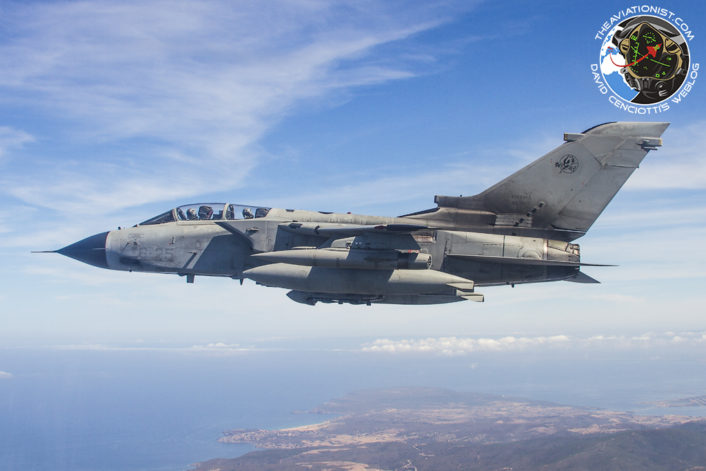
The range is used for the daylight use of the gun inert dummy bombs that replicate the ballistic performance of free fall weapons. PGMs (Precision Guided Munitions) can be dropped inside Capo Teulada range, north of Frasca (not used during this campaign). Both ranges are located within few minutes flight time from the airbase and this means that units deployed to Deci fly more than they usually do when they operate from their homebases, where the rate of sorties can be affected by the adverse weather, rather rare in Sardinia. In addition to favorable weather conditions, Deci also offers extensive airspaces and logistic and support infrastructures that make the base ideal for firing activities.
Capo Frasca range
Two kind of training events can take place inside Frasca range: “hot” (when inert weapons are dropped) and “dry” (when no armament is dropped). The same sortie usually includes some dry passages, needed to get accustomed to the range environment and targets, followed by hot ones. The targets are easily identifiable wooden pyramids or cubes, located in the north of the peninsula: represented by various white circles, they are numbered to distinguish them from one another in radio communications with the RSO (Range Safety Officer), who works in the range control tower alongside two non-commissioned officers, responsible of the electronic sensors.
These sensors are a series of cameras that triangulate the impact of the dummy bomblets on the target, for all the events that involve inert bombs; microphones that detect the shock waves of the inert bullets for all the gun strafing events.
Each target is assigned a specific racetrack or pattern, an attack profile, a final heading that is designed so that the bombs can’t fall outside the perimeter of the range, and, based on the characteristics of the terrain, a type of inert weapon. For instance, the one used for training with the gun consists of two panels (right and left) installed onto a terreplein that serves to reduce the hazard of ricocheting bullets.
The range is regularly cleaned and, during the environmental requalification activities, some targets may be temporarily inhibited: for example, during our visit, Target 2 could not be used and all the training activities took place on Target 5. On the latter, a level bombing procedure sees the Tornado approaching the target at 200 feet (Radar-Alt), 480 KIAS (480 knots of indicated are speed), wings at 45 degrees. Then, at the pre-planned slant range, the aircraft drops the dummy bombs and radios the “OFF” to the RSO, disengaging the target. Even though the range is only used under visual conditions, Tornado aircrews use radar fixes taken from the Navigator (NAV – the Italian designation for the Weapons System Officer) using surface features on the ground: initially, the Tornado IDS needed these fixes to realign the inertial platform and compensate for the drift of the INS (Inertial Navigation System). Now that the platform is serviced to a GPS, realigning the INS during the flight is no longer required, but the geolocation check procedure is still used for training purposes.
The radar is also used to “mark” the target: metal plates are installed underground in the target area to make it reflective. If the coordinates computed by the Tornado were different from those provided ahead of the take-off, the target bars that show the target position in the HUD (Head Up Display) would be off the actual target. For this reason, while approaching the drop point, the aircraft turns on the radar to “paint” and mark the target and update its position so that the bars in the HUD are properly aligned; a sort-of tuning that can also be done by the pilot, manually, based on the visual identification of the target. For missions at the range, the Italian Tornados carry two CBLS (Carrier Bomb Light Stores), each loaded with four dummy bombs: Mk.106 or DM.18 (high-drag) and BDU-33D/B or B/B (low-drag).
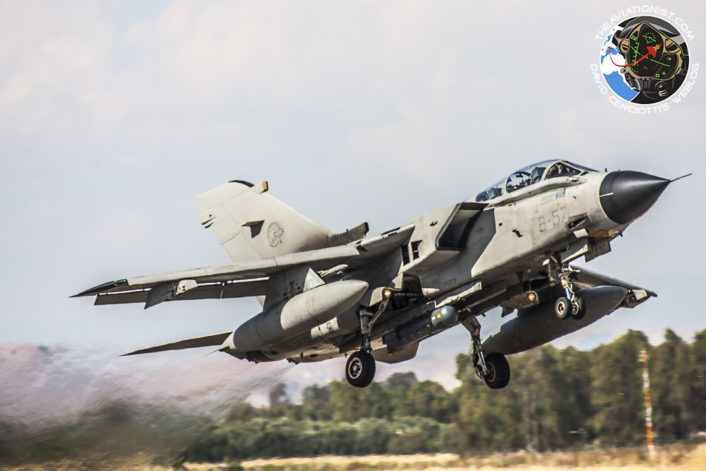
The cylindrical-shaped “high-drag” ones, with kinematic characteristics similar to those of the retarded bombs (such as the “Snakeye”), are used for “low” events: “level”, “glide 5” or “glide 10” events, when the slant range is short and the maximum drop altitude is 5,000 feet. For the “high” events, that is to say events that start from 5,000 feet or more, low drag inert bombs are used. In order to get an idea of how the target during the attack, pilots deployed to “Deci” are given photographs taken from a helicopter: the shots provide a pretty accurate “picture” of how the target will appear from the cockpit during the final approach to the target. Dealing with Capo Teulada, in southwestern Sardinia, the main activity carried out there is training with JTACs (Joint Terminal Attack Controllers) with inert weapons. Inside PISQ, in central eastern Sardinia, no air-to-surface events are carried out: the Tornados fly at night inside the Electronic Warfare range to train in reacting to anti-aircraft threats and assessing how certain enemy systems’ radio-frequencies are captured by the on-board RWR (Radar Warning Receiver).
Along with the dummy bombs carried on the two CBLS containers and the two drop tanks, the Italian Tonkas normally fly with the BOZ-102 chaff and flares dispensers; however, whenever needed for maintenance purposes, the aircraft can fly to the range without any pod or fuel tank, in a so-called “super clean” configuration.
At this point one might guess what’s the reason for using dummy free fall bombs considered that the current and future scenarios require the “smart” weaponry. The reason is quite simple: this kind of training is extremely formative. Some of the attack profiles used to drop inert weapons on targets under visual conditions are quite similar to those used to deliver LGBs (Laser Guided Bombs). Therefore, pilots learn first how to use dummy bomblets then, when they are proficient at using these low-cost inert bombs, they can pass to the next level.
Moreover, although most of the real missions are flown at medium/high altitude, low level flying remains important:
“It’s true: in theatre, we normally operate at higher altitudes. However, even in the most complex scenarios, flying low remains an option when you need to evade threats. Even more so when you fly the Tornado, an aircraft that has been designed to fly at treetop altitude: terrain masking is an option you can rely on. This is the reason why most of our training takes place at low altitudes. In the past, our low flying training took place in Italy, then, for a certain period, we have deployed to Goose Bay, in Canada; more recently we have exploited the deployments to Israel to fly as low as 250 feet during multinational exercises.”
Dealing with training, about 60% of the flying hours assigned to the 154° Gruppo are spent on Air Interdiction missions; 30% are CAS and air support missions to the Italian Army and Navy (including TASMO – Tactical Air Support to Maritime Operations); and only 10% are reconnaissance missions. Even though “recce” missions have been the Gruppo’s “core business” during the most recent real operations, the time spent training in this role is pretty low if compared to the rest of the task types, also thanks to the RecceLite pod, that has significantly reduced the effort on the aircrew.
“The pod we use today is much more advanced than that we had in the past and has simplified our work. The RecceLite has the same form factor as the Litening targeting pod; although it is not equipped with laser and therefore does not allow the delivery of any kind of precision weaponry, it features digital recording and real-time imaging capabilities. The pod can also be used in air-to-air mode for the identification of other aircraft; an operating mode that may be useful in some scenarios, such as in Kuwait or Iraq, where two AIM-9L air-to-air missiles for self-defense were the only weapon we carried and we could use the pod to perform long-distance visual identification of other traffic, increasing our SA [Situational Awareness].”
During the deployment to Decimomannu, the 154° and 155° Gruppo operate more or less the same way they have been doing since the “Panthers” moved from Piacenza to Ghedi to join the local-based 6° Stormo last year.
“With the arrival of the 155°, we are able to carry out joint missions more frequently than before. We are much more integrated, so much so that the daily plan includes mixed crews from time to time, usually with a 154° pilot and 155° NAV, since they retain an air-to-ground role: in these cases, the training missions will focus on the use of GPS-guided weapons also carried by the ECR. Although possible, the opposite (that is a 155° pilot pairing with a 154° NAV) is rather rare, considered the 155th peculiar role, that requires a special training by the navigator”.
By the way, in terms of dummy weapons employment, the workload is mainly on the pilot side; when it comes to using precision-guided weaponry, the workload particularly heavy on the NAV side. Operating out of Decimomannu is not too different from launching sorties during a real operation: unlike what happens at home, where aircrews are required to perform also administrative tasks, when deployed, the aircrews only focus on planning, executing, debriefing the missions and then start again.
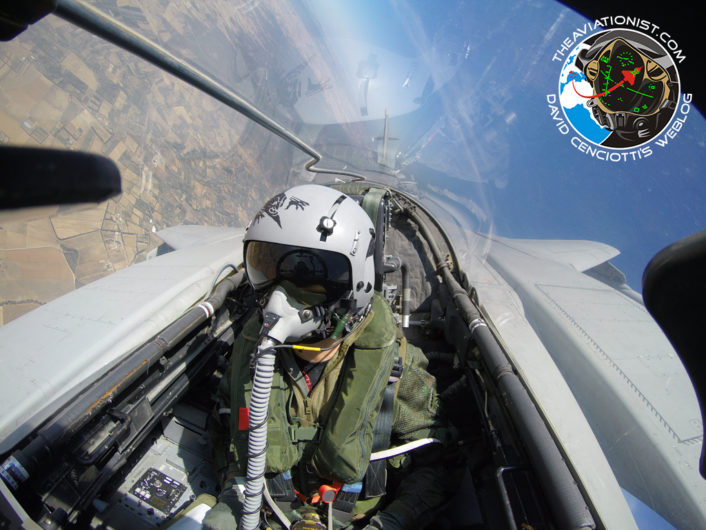
“Our job is roughly the same even though it is done with greater intensity; the real difference is that there is no space for the paperwork during deployments: basically, we only fly. This happened in Afghanistan, during our first overseas deployment to support a real operation after many years and a real test bed for the whole squadron; it happened in Libya, during which we operated from Trapani using all the precision weaponry we are equipped with; and was the same in Iraq, the most recent mission we have carried out and one of the most complex ones: the scenario saw us flying very long missions (up to 6-7 hours), that required 3-4 aerial refuelling operations, in difficult climatic conditions, with temperatures often around 50 degrees Celsius. Compared to a “normal” detachment in Deci, real operations require a peculiar turnover: in Afghanistan and Iraq we shifted the aircrews every 2 months while in Libya, due to the proximity of the deployment base, we were able to make bi-weekly rotations. Here in Sardinia we remain for a maximum of two weeks” concludes Fabio.
155° Gruppo
The peculiar role of the 155° Gruppo is to leverage the capabilities of the Tornado ECR to suppress enemy air defenses. To accomplish this mission, the Squadron relies on the Sezione Obiettivi e Guerra Elettronica (Targets and Electronic Warfare Section), a unit that is responsible for compiling, updating and managing the Electronic Warfare libraries used by the ECR fleet for carrying out their mission. The activity of the Section is complementary to that of the ReSTOGE (Reparto Supporto Tecnico Operativo Guerra Elettronica – Electronic Warfare Technical Support Department): whilst the ReSTOGE deals with the updates of the self-protection libraries of all the Italian Air Force aircraft (therefore, not just for the Tornado fleet), the Section manages and makes available to the 155° Gruppo the “targeting” libraries, the information that the Squadron would use to attack enemy defenses. Dealing with the activities carried out at Decimomannu, the “Black Panthers” usually deploy to Sardinia once a year. “In Sardinia, we carry out a variety of missions” explains T.Col. Stefano R., commander of 155° Gruppo.
“We perform training activities aimed at delivering weapons; air-to-air missions inside the ACMI (Air Combat Maneuvering Installation) range to practice evading aerial threats, and night activity with the NVGs inside the PISQ range. In the latter case, we exploit the light conditions we find inside the EW range, that are far better than those that we can find flying over the Pianura Padana [Plain of the Po] were the light pollution creates visual conditions that are not optimal for the use of night vision goggles. The PISQ is really “dark” and this helps up preparing night SEAD scenarios perfectly tailored to our needs. The basic training for all the aircrews that are assigned to the squadron (and until they achieve the Combat Readiness status) as well as pilots and NAVs who need to keep their currencies, takes place at the Polygone. This range offers a lot in terms of available threats, including real and simulated air defense systems, and provides an immediate feedback on the effectiveness of the used tactics. Although complete, the type of scenarios the Polygone offers is quite basic, in terms of complexity, so we carry out the most advanced part of our training during multinational exercises (such as those in Israel or the Red Flag in the US), especially those drills that have a particular focus on EW. That said, we deploy to Deci for that niche training (night SEAD with NVGs) that would be difficult to arrange and perform abroad. Besides flying in the EW ranges we carry out joint training missions with the Italian Army and Navy as well as the Air Force’s own Spada anti-aircraft systems.”
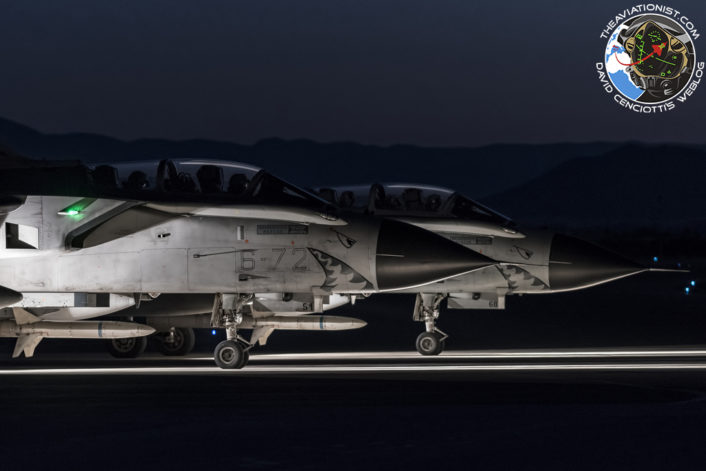
Even though it was not included in the May-June 2017 campaign, the 155° Gruppo aircrews are required to train and prove to be proficient at using PGMs through a certain number of sorties at Capo Frasca range. Indeed, JDAMs (Joint Direct Attack Munitions) have been integrated as part of the Tornado ECR RET8 “IT Full MLU” retrofit program. The 155° has achieved the mission capability qualification with the new GBU-32 JDAMs (the same carried by the Tornado IDS), with a DEAD (Destruction of Enemy Air Defenses) mission last year. It’s not only a matter of syntax, there are substantial differences between a SEAD and a DEAD mission, with the latter aiming at destroying the whole system. “The HARM can prevent the employment of a defense system hitting its radar. The damage on the antenna temporarily denies the use but does not destroy the whole system: if a replacement antenna is available, the whole site becomes operational again in some (usually, short) time.” Dealing with the HARM, the missile used for SEAD missions, the Squadron has started receiving the first AGM-88E missiles that features improved ability to geo-locate and neutralize the threats: “We are designing the tactics to use the “Echo” and these will be validated with a campaign at China Lake in the next months. Meanwhile, we mainly fly with the old “Bravo” missile.”
Conceived in the 70s and as such not even comparable to a 5th generation aircraft, the Tornado ECR is still today able to hold its own: “U.S. aside, in terms of SEAD, Italy and Germany represent the only nations able to make certain capabilities available. Despite its age, the ECR is still quite effective, as proved at international level, during exercises and real operations, including the most recent one in Libya, in support of Operation Unified Protector. We are used to the “Train as you fight, fight as you train” slogan, but there are always differences. In particular, our experience over Libya has been important to fine tune some procedures and tactics that needed to be refreshed and updated to become applicable to the current scenario.”

With the somehow imminent phase-out of the Tornado, it’s the availability of the Weapons System Officers (who particularly important on the ECR since they manage the Emitter-Locator System, the other on board sensors and the missile), rather than the age of the aircraft to raise some concern. Indeed, even though both Tornado variants will be replaced by the F-35 (with officers of various experience already scheduled to transition to the 5th generation aircraft), the JSF will initially substitute the IDS aircraft. For this reason, the 155th Squadron continuously monitors the availability of a sufficient number of NAVs until the ECR is retired. “From a training stand-point, the courses to qualify new NAVs, previously delivered by the U.S. Navy at Pensacola, ceased some years ago. Since then, we have trained two new officers “in house”, through special courses delivered by the 61° Stormo at Lecce. However, the training requires a lot time hence, filling the gap with new officers will be considered taking the residual flying hours into account.”
A slightly different version of this article was published in the October 2018 issue of “Combat Aircraft”.

